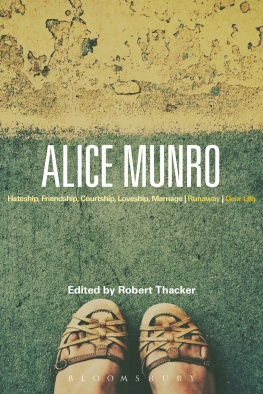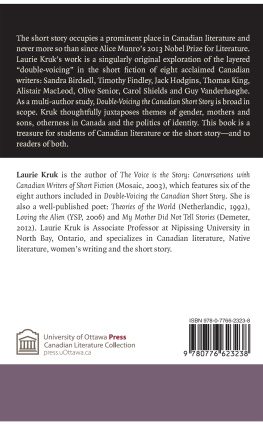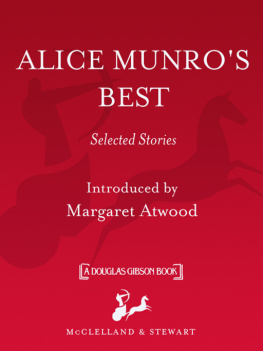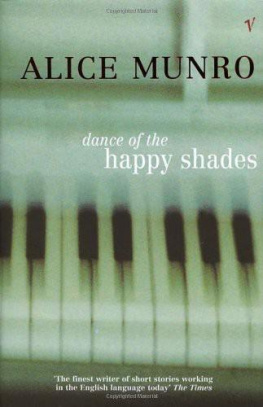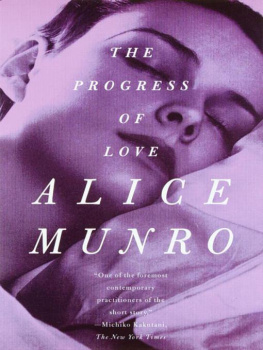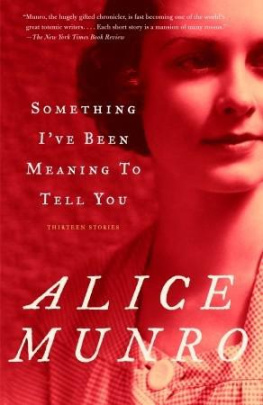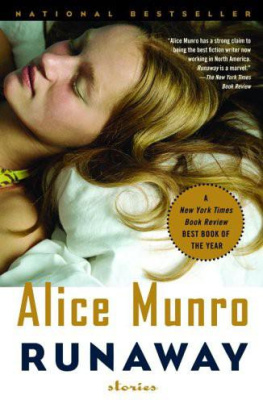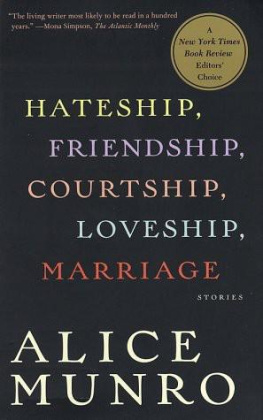Alice Munro
BLOOMSBURY STUDIES IN CONTEMPORARY NORTH AMERICAN FICTION
Series Editor: Sarah Graham, Lecturer in American Literature, University of Leicester, UK
This series offers up-to-date guides to the recent work of major contemporary North American authors. Written by leading scholars in the field, each book presents a range of original interpretations of three key texts published since 1990, showing how the same novel or collection may be interpreted in a number of different ways. These informative, accessible volumes will appeal to advanced undergraduate and postgraduate students, facilitating discussion and supporting close analysis of the most important contemporary American and Canadian fiction.
TITLES IN THE SERIES INCLUDE:
Bret Easton Ellis: American Psycho, Glamorama, Lunar Park Edited by Naomi Mandel
Cormac McCarthy: All the Pretty Horses, No Country for Old Men, The Road Edited by Sara Spurgeon
Don Dellio: Mao II, Underworld, Falling Man Edited by Stacey Olster
Louise Erdrich: Tracks, The Last Report on the Miracles at Little No Horse, The Plague of Doves Edited by Deborah L. Madsen
Margaret Atwood: The Robber Bride, The Blind Assassin, Oryx and Crake Edited by J. Brooks Bouson
Philip Roth: American Pastoral, The Human Stain, The Plot Against America Edited by Debra Shostak
Leslie Marmon Silko: Ceremony, Almanac of the Dead, Gardens in the Dunes Edited by David L. Moore
Toni Morrison: Paradise, Love, A Mercy Edited by Lucille P. Fultz
To Virginia Barber, Who Helped Make Alice Munros Stories
Alice Munro
Hateship, Friendship, Courtship, Loveship, Marriage, Runaway, Dear Life
Edited by
Robert Thacker
Bloomsbury Academic
An imprint of Bloomsbury Publishing Plc

Contents
The idea for this volume first came from David Avital at Bloomsbury AcademicI am grateful that he suggested it and then helped me make it happen. Throughout, he has always been interested and encouraging. So too has Mark Richardsonalso at Bloomsburybeen throughout. Sarah Graham, Series Editor for Bloomsbury Studies in Contemporary North American Fiction, has been a delight to work with too: encouraging, helpful, and precise.
My planning for the volume took a great leap forward when I attended the Alice Munro Symposium sponsored by the University of Ottawa in May 2014. Most of the contributors here attended and spoke there too, so I was able to talk to them about plans, enquire about possibilities, and commission specific chapters. I am very grateful to each of the contributors here, and I especially appreciate their prompt responses to my many, many requests. I want particularly to thank Lester E. Barber who, when he learned of my difficulties in obtaining another essay, enthusiastically stepped in on very short notice with the essay included here. I appreciate his willingness, his speed, and his fine work.
Among those gathered at the Ottawa Munro Symposiumstunningly planned by Janice Fiamengo and Gerald Lynch of the Department of English therewere her longtime agent, Virginia Barber, and three of Alice Munros editors: Ann Close (Knopf), Douglas Gibson (first at Macmillan of Canada and then, after 1986, McClelland & Stewart), and Daniel Menaker (one of several she has had at New Yorker other longstanding editors are Charles McGrath and Deborah Treisman). The four people gathered in Ottawa offered a singular panel focused on working with Alice Munro over the years; they were a one-of-a-kind gathering, replete with wit, humor, and pleasure over having been lucky enough to have worked so closely with this great writer, Alice Munro. Acknowledging the many, many kindnesses and helps these same people have extended to me over the years of our association, I join with them, and with all the contributors gathered here, in acknowledging the profound clarity and unsurpassable artistry of Alice Munro. As Ive written many times before and probably will write yet again beyond this volume, her work most truly is a fine and lucky benevolence ( Something 43).
Each study in this series presents ten original essays by recognized subject specialists on the recent fiction of a significant author working in the United States or Canada. The aim of the series is to consider important novels or story collections published since 1990 either by established writers or by emerging talents. By setting 1990 as its general boundary, the series indicates its commitment to engaging with genuinely contemporary work, with the result that the series is often able to present the first detailed critical assessment of certain texts. In respect of authors who have already been recognized as essential to the canon of North American fiction, the series provides experts in their work with the opportunity to consider their latest novels in the dual context of the contemporary era and as part of a long career. For authors who have emerged more recently, the series offers critics the chance to assess the work that has brought authors to prominence, exploring novels that have garnered acclaim both because of their individual merits and because they are exemplary in their creative engagement with a complex period. Including both American and Canadian authors in the term North American is in no sense reductive: studies of Canadian writers in this series do not treat them as effectively American, and assessment of all the chosen authors in terms of their national and regional identity, as well as their race and ethnicity, gender and sexuality, religion and political affiliation is essential in developing an understanding of each authors particular contribution to the representation of contemporary North American society. The studies in this series make outstanding new contributions to the analysis of current fiction by presenting critical essays chosen for their originality, insight, and skill. Each volume begins with a substantial introduction to the author by the studys editor, which establishes the context for the chapters that will follow through a discussion of essential elements such as the writers career, characteristic narrative strategies, themes, and preoccupations, making clear the authors importance and the significance of the novels chosen for discussion. The studies are all comprised of three parts, each one presenting three original essays on three key recent works by the author, and every part is introduced by the volumes editor, explaining how the chapters to follow engage with the fiction and respond to existing interpretations. Each individual chapter takes a critical approach that may develop existing perceptions or challenge them, but always expands the ways in which the authors work may be read by offering a fresh approach. It is a principle of the series that all the studies are written in a style that will be engaging and clear however complex the subject, with the aim of fostering further debate about the work of writers who all exemplify what is most exciting and valuable in contemporary North American fiction.
Sarah Graham
Robert Thacker
No writer of fiction of comparable genius has depended so much, for so long, on short stories alone...
RANDALL JARRELL, ON PREPARING TO READ KIPLING (1961)
The fall of 2012 saw the publication of Alice Munros Dear Life: Stories , her fourteenth book. While such things are uncertain, just as everyones dear life is, it will likely be Munros last book. As has long been her practice, Dear Life is mostly made of stories that readers had seen before in periodicalssix were in the New Yorker , two in Harpers , another two in Granta , and one each in Narrative and Tin House but as a collection, a whole gathering, it offers a different feel. One borne of arrangement and created experience. As the tenth story, Dolly, ends there, its narrator speaks of the rage and admiration she feels toward her longtime partner, Franklin, over a detail from what has just occurred there: It went back through our whole life together. The reader then turns to the facing page, one headed Finale, and finds the following authors comment:

